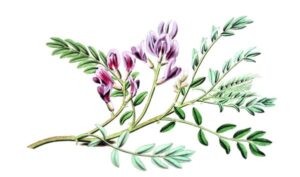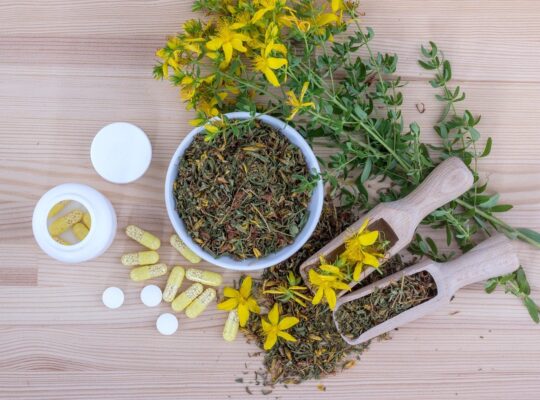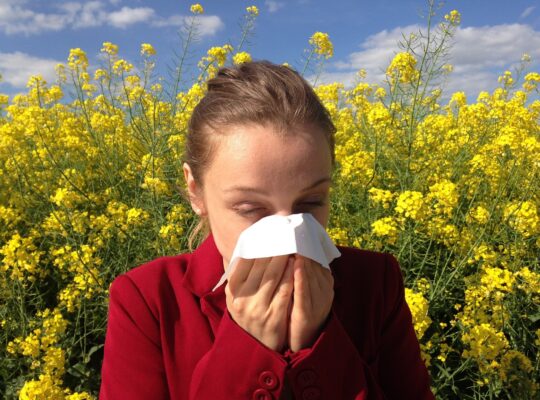
PHYLOGENETIC INFORMATION:
- Phylum: Angiosperm
- Class: Eudicot
- Family: Fabaceae
- Genus: Astragalus L.
- Species: A. propinquus (syn. A. membranaceus), A. mongholicus (syn. Phaca membranacea)
- Common Names: Astragalus [root], Radix Astragali/Astragali Radix, milk vetch, membranous milk vetch, Chinese milk vetch, Mongolian milk vetch, Bok kay
- Traditional Chinese Medicine (TCM): Huang qi
Astragalus membranaceous is a flowering plant within the vastly popular category of Astragalus. It is classified within the Fabaceae or Legume (Pea/Bean) family, the genus, Astragalus L., and the species of A. membranaceous (syn. A. propinquus) or A. mongholicus (syn. Phaca membranacea). (“Phaca”)
Astragalus is the largest angiosperm genus, with 400 species and 28 genera in North America incorporated into over 2,500 species worldwide. (Sanderson)
BOTANICAL INFORMATION:
Although A. membranaceous is native to China, “the genus [Astralagus] [tends to be] distributed in colder and arid and semiarid parts of the North Hemisphere and South America, and to a lesser extent in Mediterranean regions. It is especially diverse in southwest Asia (1000-1500 spp.), the Sino-Himalayan region (500 spp.), western North America (400 spp.), and the Andes and Patagonia in South America (100 spp.).” (Sanderson)
As a hermaphrodite, herbaceous, and perennial plant, it “thrives in part to full sun in well-drained soil,” particularly “dry sandy soils” in which the soil (or the seed) has been inoculated with mycorrhizal fungi/bacteria “to assist with germination and growth.” (“Astragalus [Plants]”, “Strictly”) In other words, “astragalus likes sandy soil, full sun, and low nitrogen levels.” (“Astragalus Monograph”)
Identified by its “pinnately divided leaves consisting of many smaller leaflets” and “yellow flowers “giving way to pea-like follicles,” growing 4-6 feet tall. (“Astragalus membranaceus”, Elpel) Aside from its aerial parts, its medicinal value lies in its taproot, which is not harvested for three or four years, to ensure it grows “to [a] harvestable size.” (“Strictly”) Although it’s often imported from China, astragalus “is an easy plant to grow in the garden; however, you’ll need to grow numerous plants over several years to get a good quantity of root.” (“Astragalus Monograph”)
When dug up, it is oftentimes sliced and dried. “Dried astragalus is commonly sold as large, flat, tongue-depressor-looking roots. The more yellow roots are more highly prized. These roots, unfortunately, are often manipulated with yellow dyes.” (“Astragalus Monograph”)
Also, there are some plants within the Astragalus species that are toxic and thus should not be assumed as carrying the same traits as shared here. (“Astragalus Monograph”, “Astragalus Health”)
HERBAL INFORMATION:

Energetically speaking, its root has a sweet taste with a slightly warming, moistening effect. (“Astragalus Monograph”) As an immunomodulator, A. membranaceous contains “more than 100 ‘active’ compounds, including flavonoids, saponins, polysaccharides, and amino acids…The polysaccharide, triterpene, and its flavonoids fractions are all credited with immune-regulating actions…Astragaloside IV is the primary pure saponin of Astragalus, and has been shown to be important to its cytokine and T-cell modulation effects, promoting T-helper cells toward a T-helper 1 (Th1) phenotype.” (Stansbury)
Its herbal actions are “adaptogen, antioxidant, cardioprotective, diuretic, hepatoprotective, immunomodulator,” while its uses include“anti-tumor activity, promotes tissue regeneration, anti-inflammatory, antiviral, protects kidney function, hypotensive, protects against [white blood cell] WBC drops during chemotherapy, antidiabetic, neuroprotective, pulmonary protective, and hepatoprotective.” (“Astragalus Monograph”, Tilgner)
In Western herbalism, A. membranaceous “is considered a tonic to the immune system and the lungs and is taken preventively for colds and influenza.” (Tilgner) Its also known for “its ability to prevent and protect the bodies cells against cell damage and death from various toxins.” (Tilgner) This is due in part to its ability to affect “many different tissue types, including the skin, pancreas, liver, blood vessels, connective tissues, and neurons.” (Stansbury)
In Traditional Chinese Medicine (TCM), astragalus (or Huang qi) is a “primary herb” involved in “[tonifying] the immune system, or wei qi [pronounced “way-chi”] of the lungs.” (Tierra, “Astragalus Health”) The wei qi acts as “a force field for our body, protecting us from invading pathogens (bacteria, virus, etc.)” (“Astragalus Health”)
In TCM, it’s associated with the Spleen Qi tonic and the Lung Qi tonic and thereby is used for deficiencies in those areas. (“Astragalus Monograph”, “Astragalus Health”) For maximum effectiveness, it’s often paired with a complementary herb. Through a combined effort, it “balances the energy of all the internal organs.” (Tierra)
The Spleen Qi is heavily connected to the pancreas and digestive system, then “the spleen is responsible for transforming food and drink into Qi (energy) and Blood…After the Spleen transforms food and drink into Qi, the Qi ascends to the Lungs where it is combined with the Lung Qi and transformed into the Zhen Qi, or energy that supports our energy body.” (“Astragalus Health”) Thus, the Lung Qi tonic, “is useful for those who are frequently coming down with colds and the flu, have difficulty breathing, or those who sweat too much or not enough.” (“Astragalus Health”)
As an immune-modular, studies have shown astragalus is effective in combatting symptoms of seasonal allergies. In a “randomized, double-blind, placebo-controlled clinical study,” forty-one of 48 participants – all of which had a history of “grass or weed pollen…[but not] tree pollen” – completed a trial period during the months of May-June and August-October. (Oppel) Each “provided blood samples and completed the self-administered Rhinoconjunctivitis Quality of Life Questionnaire (RQLQ),” which measured symptoms associated with the nasal passage, such as “sneezing, runny nose, nasal passage obstruction,” along with “watery eyes” and other common seasonal allergy symptoms. (Oppel)
Participants were measured at the start of the study, and again after three weeks, then again after six weeks. Thirty-two participants were in the astragalus group and they were provided with a twice-daily dose of “astragalus capsules…80 mg”. The other group (n=16) were provided with “an identical-appearing placebo containing lactose powder.” (Oppel) At the conclusion of the study, “There were significant differences between the placebo and the astragalus groups after 3 and 6 weeks of treatment in TSS scores (3 weeks: P=0.037, 6 weeks: P=0.022) and mini RQLQ scores (3 weeks: P=0.017, 6 weeks: P=0.001). However, it was determined that the treatment window should have been shortened since pollen levels of exposure could have varied during the trial period (Oppel).
Aside from allergies, astragalus has long since been used for combatting the symptoms associated with cancer treatments, which is one of its common uses in TCM. In that case, it’s used “to support people diagnosed with cancer [and] is commonly used in formulas as adjunctive medicine during cancer treatments.” (“Astragalus Monograph”) Although the majority of studies to prove such in the Western are often conducted in vitro, human studies have been conducted in China but oftentimes are lost in translation.
For example, one source cites “seventeen studies with over 1500 cancer patients, [which] showed astragalus (Astragalus membranaceus) (AM) combined with conventional therapy was more effective than chemotherapy alone. Tumor sizes were reduced, and survival rates improved. Using the herb also meant fewer drug side effects, such as fatigue, poor appetite, nausea, anemia, and low blood cell counts.” (“Herbal Clippings”)
Aside from acting as a supplemental cancer treatment, Chinese studies have been conducted on the use of astragalus for the recovery of stroke patients (Chen). In a two-week trial, sixty-eight of 78 patients completed the study in which somewhere giving astragalus while others were given a placebo. In one group (Group A), thirty-six patients were given an “oral or nasopharyngeal administration at 3 grams, three times a day, and 32 patients were given a placebo. The first dose begins 24 hours after experiencing a hemorrhagic stroke.
Then on days 1, 4, and 7, blood tests were run on each patient to check inflammation markers as shown in C-Reactive Protein (CRP) and Erythrocyte Sedimentation Rate (ESR). Additional scoring was conducted at weeks 1, 4, and 12, using the functional independence measures scale (FIM) score, the Barthel index (BI) scale score, the Glasgow outcome scale (GOS) score, and the modified Rankin scale (MRS) score.
This study concluded “the FIM and GOS scores of Group A (patients treated with complementary therapy of AM) were similar to those of Group B (placebo) at baseline. The increase in FIM scores was greater than Group A at week 4, and again at week 12, relative to Group B. The increase in GOS scores was greater for Group A than Group B at week 12. The score changes for BI and MRS were not significantly different at week 4 and at week 12 compared to the first week after stroke onset.” (Chen)
With many variables, the results were quite inconclusive and ultimately show no significant differences, but was promising with FIM scores since they did show significantly greater differences in the areas of“grooming,” “bathing/showering,” and “dressing the lower body.” Therefore, the researchers suggest “a larger study to assess the efficacy of AM after stroke,” to further test the effectiveness of “for acute hemorrhagic stroke patients, if treatment with AM is started within 24 hours of stroke onset.”
There are a number of contraindications in both Western Herbalism and in TCM. In the latter, “astragalus is avoided when there [are] signs of Heat or Yin Deficiency.” (“Astragalus Monograph”) In the West, The Botanical Safety Handbook reports that astragalus could “contradict the effects of immune suppressant drugs such as cyclosporine and corticosteroids.” (“Astragalus Monograph”)
Recommended Dosages:
Per HerbMentor.com, astragalus is “sold as [a] powder, whole roots, sliced roots, or roots that are cut and sifted.” Furthermore, there are “promising clinical studies involving astragalus [for] concentrated extracts or injections.” (“Astragalus Monograph”) In the meantime, for best results, astragalus should be taken at high doses over longer periods of time. However, one should start with smaller doses and slowly increase to the desired dose since some people could experience an allergic reaction to astragalus evident through symptoms such as “headaches, tightness in the chest, insomnia, dizziness, and hypertension.” (Gardner)
-
- Decoction: 1 heaping tablespoon or ½ stick of the dry root per cup of water;
- Whole Herb (as a decoction or powder): 10-60 grams per day*
- Tincture (dried): 1:5, 3-5 ML per day
- Extract: 1:4 dry plant liquid extract
K.P. Khalsa suggests for chronic conditions – a dosage of 30 grams per day and for acute conditions, such as cold or flu, about 60 grams; whereas, HerbMentor.com recommends a daily dosage of 10-30 grams. Or, it could be drunk as a decocted tea for every day, indefinite maintenance dose; however, it’s difficult to obtain higher doses when taken as a tincture or in capsule form. (“Astragalus Monograph”)
*** Full suite of astragalus recipes are available upon request to paid clients ***
SOURCES:
“Astragalus Health Benefits.” Herbs with Rosalee. https://www.herbalremediesadvice.org/astragalus-health-benefits.html. Accessed 5 Oct. 2021.
“Astragalus Chai.” HerbMentor. https://herbmentor.learningherbs.com/articles/remedies-recipes/astragalus-chai/. Accessed 10 Oct. 2021.
“Astragalus (Astragalus membranaceus) seeds, organic.” Strictly Medicinal Seeds. https://strictlymedicinalseeds.com/product/astragalus-astragalus-membranaceus-packet-of-50-seeds-organic/. Accessed 30 Oct. 2021.
“Astragalus membranaceous – Moenfh.” Plants for a Future. https://pfaf.org/user/Plant.aspx?LatinName=Astragalus+membranaceus. Accessed 31 Oct 2021.
“Astragalus Monograph.” HerbMentor. https://herbmentor.learningherbs.com/herb/astragalus/. Accessed 10 Oct. 2021.
“Blood Building Syrup.” HerbMentor. https://herbmentor.learningherbs.com/articles/remedies-recipes/blood-building-syrup/. Accessed 26 Oct. 2021.
Chen, Chun-Chung et. al. “Chinese herb Astragalus membranaceous enhances recovery of hemorrhagic stroke: Double-blind, placebo-controlled, randomized study.” Evidence-Based Complementary and Alternative Medicine (2012):1-11.
Elpel, Thomas. (2013). Botany in a Day. Pony, MO: HOPS Press.
Five Flavors Wellness Tea. HerbMentor. https://herbmentor.learningherbs.com/articles/remedies-recipes/five-flavors-wellness-tea/. Accessed 10 Oct. 2021.
Gardner, Z, et. al. “Astragalus mongholicus.” The Botanical Safety Handbook. Boca Raton: CRC.
“Herbal Clippings: Chemo herb combo.” American Herb Association Quarterly vol 32, 2 (2017):12-13.
“How to Make Immune-Building Herbal Chai.” HerbMentor. https://herbmentor.learningherbs.com/articles/remedies-recipes/immune-building-herbal-chai/
McBride, Kami. (2019). The Herbal Kitchen. Newburyport, MA: Red Wheel.
Oppel, Marissa. “Study finds astragalus and mineral formula beneficial in treating seasonal allergic rhinitis.” HerbalGram vol 84 (2010):24-25.
“Phaca membranacea.” Royal Botanical Gardens. http://plantsoftheworldonline.org/taxon/urn:lsid:ipni.org:names:513339-1. Accessed 26 Oct. 2021.
“Relax with k.p. khalsa.” HerbMentor. https://herbmentor.learningherbs.com/course/relax/part-5-stress-and-anxiety-solutions/. Accessed 26 Oct. 2021.
Sanderson, Michael & Wojciechowski, Martin. “Diversification Rates in a Temperate Legume Clade: Are there “So Many Species” of Astragalus (Fabaceae).” American Journal of Botany vol 83, 11 (1996):1488-1502.
Stansbury, Jillian. “Astragalus: Use of the herb in the treatment of allergy & autoimmunity.” Naturopathic Doctor News & Review vol 12, 4 (2016):19-20.
Strictly Medicinal Organic Astragalus.” Peaceful Valley. https://www.groworganic.com/products/hh-astragalus-huang-qi. Accessed 30 Oct. 2021.
Tierra, Michael. (1998). The Way of Chinese Herbs. New York: Pocket.
Tierra, Michael. (1998). The Way of Herbs. New York: Pocket.
Tilgner, Sharon (2020). Herbal Medicine: From the Heart of the Earth (3rd). Pleasant Hills, OK; Wise Acres.





